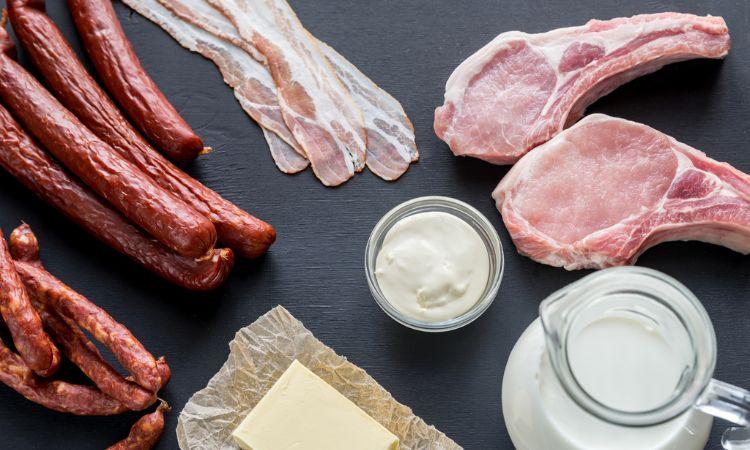The global animal fat market size reached a volume of nearly 28.64 MMT in 2023. The market is further expected to grow at a CAGR of 2.70% between 2024 and 2032, owing to the increase in demand from the foodservice sector. Animal fats, derived from various sources such as cattle, pigs, and poultry, play a critical role in multiple industries, including biodiesel, animal feed, oleochemical production, pet food, and food applications. This blog post provides a comprehensive analysis of the animal fat market, highlighting its segmentation, regional analysis, market dynamics, and competitive landscape.
Market Overview
Animal fats are classified based on their origin and characteristics, with common types including tallow (derived from cattle and sheep), lard (derived from pigs), and fats from other animals. These fats are utilized for their high energy content and versatile properties, making them valuable in various industrial and consumer applications.
Market Segmentation
By Type
Tallow/Grease
Tallow, derived primarily from beef and mutton, is widely used in the production of biodiesel, soaps, and animal feed. It is valued for its high melting point and long shelf life. The market share for tallow is substantial, driven by its availability and diverse applications.
Lard
Lard, sourced from pigs, is predominantly used in food applications due to its flavor-enhancing properties. It is also utilized in the production of pastries, processed foods, and certain cosmetic products. The growth potential for lard is significant, particularly in the food industry where demand for high-quality fats is rising.
By Application
Biodiesel
The biodiesel industry is a major consumer of animal fats. Animal fats are processed into biodiesel, which serves as a renewable alternative to fossil fuels. The market for biodiesel is growing, driven by regulatory support for renewable energy and the need for sustainable fuel options.
Animal Feed
Animal fats are a crucial component of animal feed, providing essential nutrients and energy. They are used extensively in livestock and poultry feeds, enhancing the growth and health of animals. The demand for animal feed is rising with the increasing global population and meat consumption.
Oleochemical
In the oleochemical industry, animal fats are used to produce fatty acids, glycerin, and other chemicals. These oleochemicals are integral to the manufacturing of soaps, detergents, and personal care products. The market dynamics for oleochemicals are favorable, with growing demand for natural and sustainable ingredients.
Pet Food
The pet food industry utilizes animal fats to enhance the flavor and nutritional profile of pet foods. With the increasing trend of pet humanization, there is a growing demand for high-quality pet food ingredients, including animal fats.
Food Applications
Animal fats are used in various food applications, including cooking, baking, and processed foods. They provide flavor, texture, and stability to food products. The health considerations and consumer preferences for natural fats are driving the market for animal fats in food applications.
Others
Other applications of animal fats include their use in industrial lubricants, candles, and pharmaceuticals. These emerging trends and innovations are expanding the market for animal fats.
Regional Analysis
The animal fat market is segmented into key regions, each with its unique market dynamics and growth potential.
North America
North America is a significant market for animal fats, driven by the demand from the biodiesel and food industries. The region’s focus on renewable energy and sustainable food production supports the growth of the animal fat market.
Europe
Europe’s animal fat market is influenced by stringent regulations on renewable energy and sustainable practices. The region’s well-developed biodiesel industry and consumer preference for natural ingredients contribute to market growth.
Asia Pacific
The Asia Pacific region is experiencing rapid growth in the animal fat market, fueled by the expanding food processing and animal feed industries. The increasing population and urbanization in countries like China and India drive the demand for animal fats.
Latin America
Latin America’s market for animal fats is growing, supported by the region’s strong livestock industry and rising biodiesel production. The region’s focus on sustainable agricultural practices also promotes market growth.
Middle East & Africa
The Middle East & Africa region shows potential for growth in the animal fat market, driven by the demand for animal feed and food applications. The region’s developing industrial sector also contributes to the market expansion.
Market Dynamics
SWOT Analysis
Strengths
- High energy content and versatile applications of animal fats
- Availability of raw materials from livestock industries
- Increasing demand for renewable energy sources
Weaknesses
- Health concerns associated with saturated fats
- Fluctuating prices of animal fat due to supply chain issues
- Competition from vegetable oils and synthetic alternatives
Opportunities
- Growing biodiesel industry and renewable energy initiatives
- Rising demand for natural and sustainable ingredients in various industries
- Innovations in animal fat processing technologies
Threats
- Regulatory challenges and environmental concerns
- Shifts in consumer preferences towards plant-based alternatives
- Economic uncertainties affecting livestock production
Porter’s Five Forces Analysis
Threat of New Entrants
The threat of new entrants in the animal fat market is moderate, given the significant investment required in processing facilities and regulatory compliance.
Bargaining Power of Suppliers
Suppliers of raw materials have moderate bargaining power, influenced by the supply-demand dynamics in the livestock industry.
Bargaining Power of Buyers
Buyers have moderate to high bargaining power, driven by the availability of alternative fat sources and price sensitivity.
Threat of Substitutes
The threat of substitutes is high, with vegetable oils and synthetic fats providing viable alternatives to animal fats.
Industry Rivalry
Industry rivalry is intense, with numerous players competing on the basis of price, quality, and innovation.
Competitive Landscape
The competitive landscape of the animal fat market features major players such as Darling Ingredients, Inc., Cargill, Incorporated, and Archer Daniels Midland Company. These companies are focused on expanding their production capacities, investing in research and development, and forming strategic partnerships to enhance their market position.
Recent developments include advancements in animal fat processing technologies, expansion of production facilities, and strategic acquisitions. The market share analysis of key players indicates a competitive environment with opportunities for growth and innovation.



